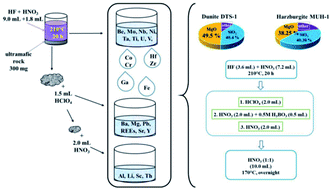An investigation of trace elements' behavior during chemical preparation of ultramafic matrix rock samples using bomb digestion for analysis by ICP-MS†
Abstract
Dissolution of trace and matrix elements during chemical treatment was studied using an ultramafic reference sample of dunite, DTS-1. Two kinds of spikes were used to enhance the extremely low concentrations in the analyzed fractions and to cross check effects, which could come from differences in the matrix and species of the added elements. They were an aliquot of the standard solution in nitric acid and a test portion of the control ultramafic alkali rock sample of the nephelinite NKT-1. A total test portion of 300 mg was chosen for the investigation taking into account the possible heterogeneity of the ultramafic rock samples. More than 77% of Be, Mo, Nb, Ni, Ta, Ti, U and V; 65–85% of Zr and Hf; 32–52% of Co, Cr and Ga; 20–32% of Fe; 10–20% of Al, Pb, Sc, and Sr and about 5% of Ba were dissolved during the bomb digestion stage. Rare earth elements (REEs), Y, Th, Li and Mg were found in the precipitate. The first treatment with perchloric acid resulted in dissolution of a majority of the precipitate. But more than 80% of Al, Th and about 70% of Li and Sc were caught with the residue that still remained after the first treatment. Seven schemes of the chemical preparation were studied using the dunite DTS-1 and the harzburgite MUH-1. The bomb digestion of a 300 mg test portion of the samples using a mixture of HF : HNO3 in ratios of 5 : 1, 1 : 1 and 1 : 2 resulted in complete decomposition of spinel, which is the most resistant ultramafic rock mineral to be dissolved. The main problem discovered was to dissolve elements which were caught with the residue that formed at the bomb digestion stage and contained predominantly MgF2. For accurate simultaneous determination of Ba, Be, Co, Cr, Cs, Ga, Hf, Li, Mo, Nb, Ni, Pb, Rb, Sc, Sr, Ta, Th, U, V, Zr, REEs and Y in ultramafic rocks with various MgO contents, it is necessary to use the mixture of HF : HNO3 with a ratio of 1 : 2 at the bomb digestion stage and perchloric, boric and nitric acids in subsequent evaporation steps.



 Please wait while we load your content...
Please wait while we load your content...